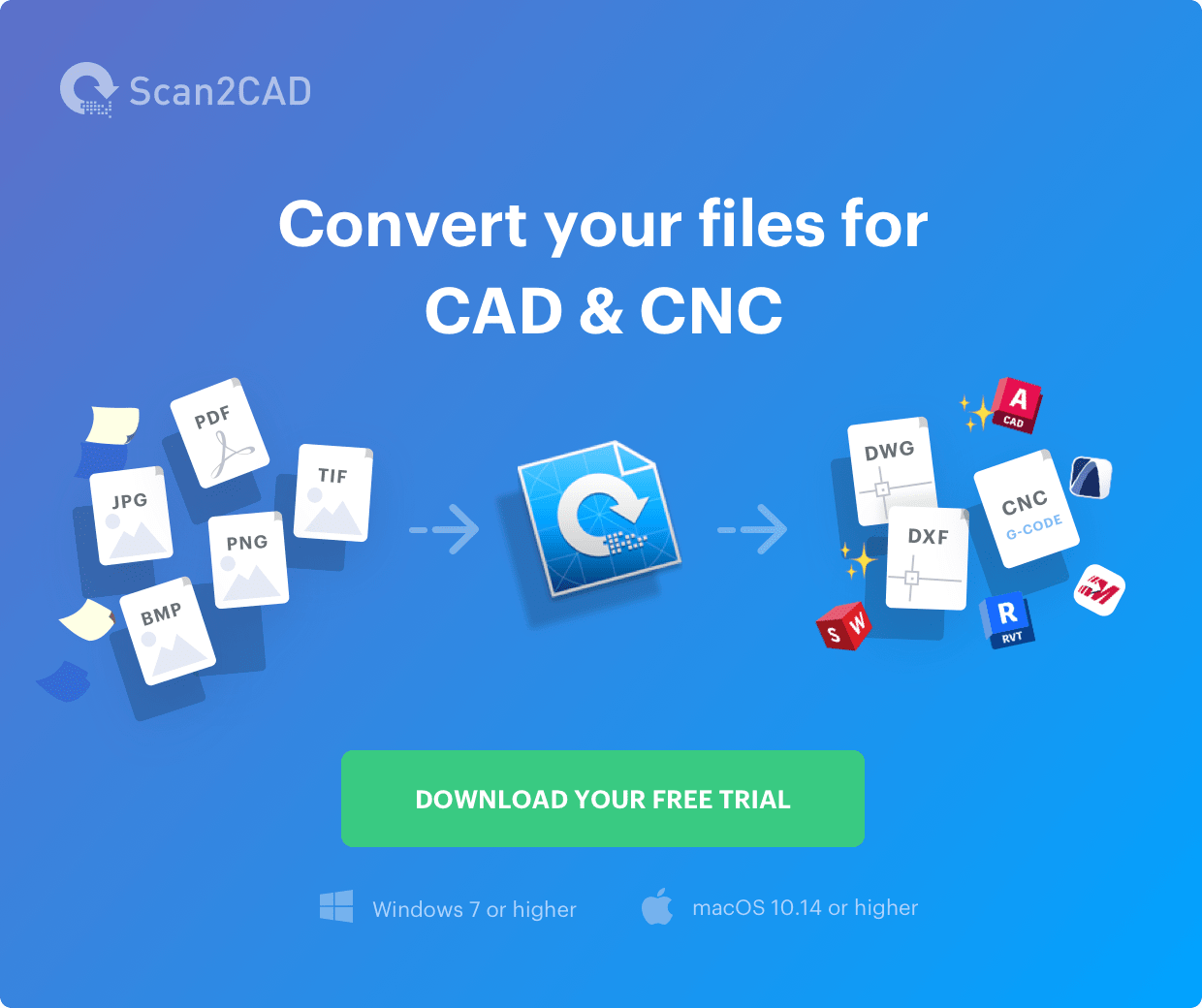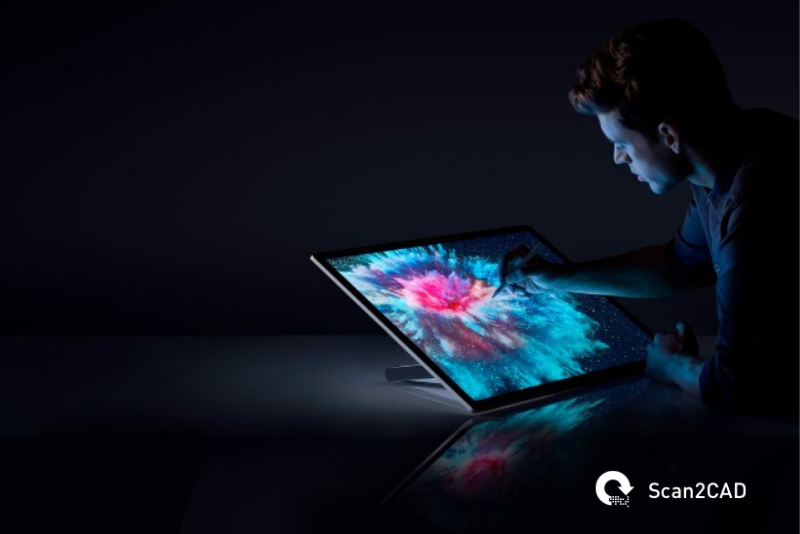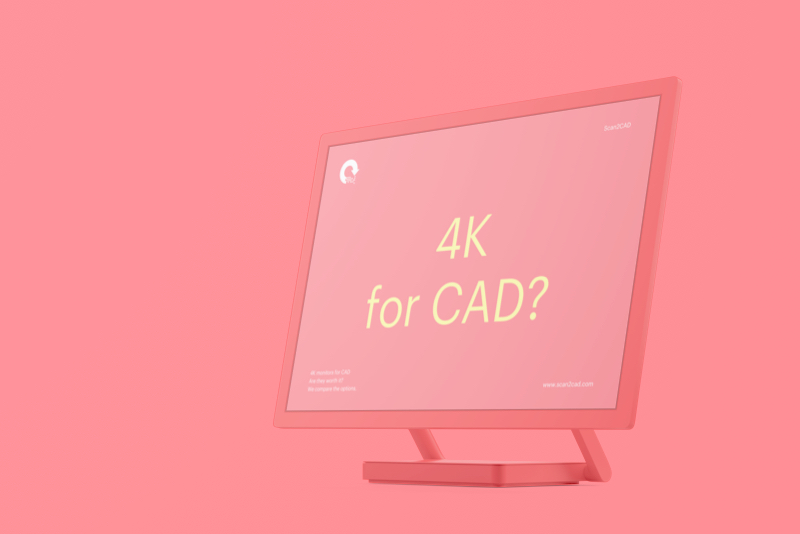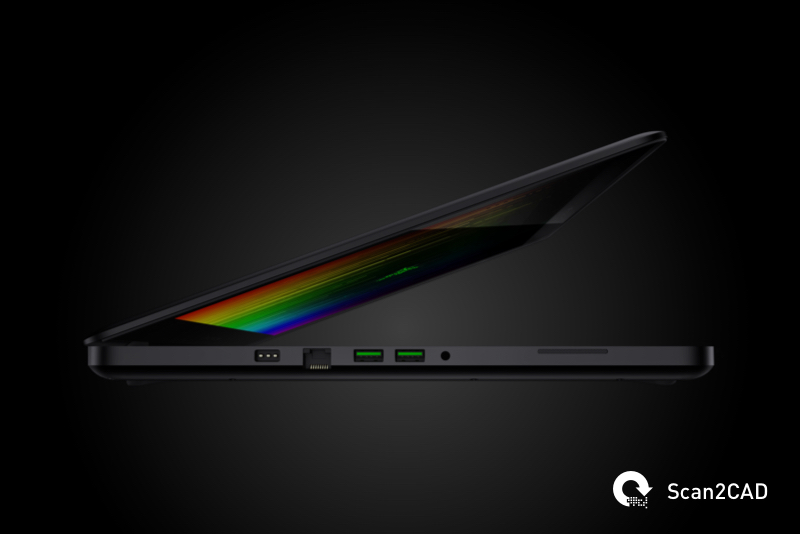Once upon a time, only huge mainframe computers could run CAD. Thankfully, over the years, desktop computers that had enough power to run CAD applications became available. For a while, engineers and designers were content but another problem arose. The need for mobility. It was impossible to move desktop computers around but this movement was required to make work faster. Then came the solution; laptops. Again, all was well but if you think that everyone was content, think again. It didn’t take long for engineers and designers to start to look for on-the-go mobility.
Some designers tend to be on the move and they love their work to go with them sometimes to beat deadlines, other times so as not to interrupt the flow of design creativity, and other times to be ready for a “Eureka” moment. As compact as laptops are, they don’t always solve the work-on-the-go issue as they are still considered a bit bulky for this purpose by many engineers and designers. So how does one get handheld mobility combined with the computing power required for CAD? The answer is Tablet Computers. Many CAD software developers, recognizing the need to work on the go, have fully functional versions of their products for tablets.
Now, there are thousands of tablets available in the market today. From play tabs for kids to mobile cinemas to powerful computers. How does one know which one of these would be perfect for running CAD applications? To help answer this question, we at Scan2CAD, after a lot of research, have come up with a list of the best tablets for CAD.
In this article, we will be reviewing the top 5 tablet computers for CAD, what makes them great, their features, their prices, where to buy them, and much more. Note that some of the products on our list are 2-in-1 laptops and tablets known as convertibles.
Table of Contents
Choosing the Right CAD Tablet: Key Features to Consider
With the market filled with plenty of tablet models and brands, choosing the best tablet for CAD applications can be difficult. However, selecting the best from even a shortlist of options can remain challenging. Nonetheless, the ‘best tablet for CAD’ status is not dependent on the manufacturer. Rather, it depends on the tablets’ capabilities and features, which are directly influenced by the following:
- Central Processing Unit (CPU)
- Graphics Processing Unit (GPU)
- RAM and storage
- Display
- Battery life
- Connectivity and ports
- Accessories
- Build quality and durability
- Operating system and software
- Price and value for money
1. CPU
The CPU of a device is considered as its brain. It is where the majority of tasks are processed. An insufficiently powerful CPU would lead to a lot of lagging during basic activities such as launching CAD software; creating, saving, importing, and exporting files; switching between interfaces; and applying general instructions. Thus, the CPU determines the tablet’s speed and the types of applications it can run.
CAD applications, especially those with 3D modeling capabilities, consume significant CPU resources. This is because of the mathematical calculations the CPU needs to complete to help the CAD software define complex geometry or represent boundaries.
The processor also promotes multitasking, which is why most processors on the market have multiple cores. But most CAD applications do not take advantage of the higher core count, as they are designed to utilize just a single core. Still, it is necessary to choose a tablet that is supercharged by a multi-core processor because you are bound to use it to run multiple applications simultaneously.
2. GPU
The primary function of the GPU is to render high-resolution graphics. The GPU handles CAD tasks such as simulation, rendering, visualization, presentation, and animation. A powerful GPU is required to perform these tasks properly. But keep in mind that not all graphics cards are ideal for CAD work. In fact, it is crucial to avoid gaming GPUs and instead go with CAD tablets that are equipped with professional GPUs.
Why are gaming GPUs not appropriate for professional work? The answer boils down to the GPU drivers, which have not been extensively tested and optimized for professional tasks. Professional GPUs come with drivers that have been tested and optimized for professional work. Moreover, their BIOS and other firmware are configured to ensure compatibility with CAD applications and other professional software, as well as stability and reliability. They are, therefore, suited for tasks like CAD, 3D modeling, scientific simulations, animation, video editing, and more. Professional GPUs typically offer higher memory capacities compared to gaming GPUs.
While it may not be practical for tablet manufacturers to include professional GPUs because of the thin frames, you could consider choosing a 2-in-1 laptop. Such laptops have the space to accommodate mobile pro GPUs.
3. RAM and Storage
The minimum recommended RAM and storage for Windows tablets is 16GB and 256GB, respectively. When it comes to iPads, however, Apple does not allow you to choose the iPad’s RAM, even though it offers two options (8GB and 16GB). Instead, you can only choose the storage. And given that the iPad is optimized for mobile use, the minimum 128GB storage can suffice. But if your workflow demands higher storage, purchasing an iPad with higher storage won’t hurt.
Device manufacturers that sell Android tablets offer various RAM and storage options. For instance, Samsung, which manufactures and sells the Samsung Tab, allows you to choose among three RAM options – 8GB, 12GB, and 16GB – while OnePlus, which manufactures the OnePlus Pad, lets you choose between two options – 8GB and 12GB. The Android tablets are optimized for mobile use, so a minimum storage of 128GB is sufficient. But keep in mind that these tablets can support up to 1TB of storage.
A high RAM and storage capacity provides a lot of legroom to productively complete demanding tasks. For example, a tablet with ample storage space eliminates concerns about the size of files you create or import. Similarly, a RAM that meets the minimum threshold provides enough resources to run even the most demanding CAD programs. Such RAM does not rapidly or easily fill up. Put simply, RAM and storage impact tablet performance.
4. Display
Most tablets, including high-end devices, do not have 4K displays. This is mainly because of their smaller sizes compared to monitors’ and laptops’ screens. However, most tablets feature high-resolution screens with Full HD (1080p) or better. High-resolution displays are perfect for CAD applications because they provide a greater sense of precision when working with complex geometry and shapes. They also enable users to visually describe the ideated beauty and aesthetics of their creations.
In addition to offering tablets with high-resolution displays, some manufacturers go the extra mile by including technologies that improve such display characteristics as brightness and contrast. The 12.9-inch iPad, for instance, uses Apple’s mini LED display backlight technology. Although it is an LCD screen, it includes thousands of LEDs, which better illuminate the overlying LCD panel, thus delivering higher brightness and better dynamic range and contrast.
In summary, it is essential to purchase a tablet whose display has a high resolution (a minimum of 1080p) and delivers high brightness, contrast, and dynamic range.
5. Battery Life
Generally, the bigger the device, the higher the battery capacity. This logically also leads to better battery life. However, the battery life also depends on software optimization and hardware components. For instance, devices with ARM-based processors generally offer better battery efficiency compared to those with x86 architecture processors. For context, Android tablets, iPads, and the Surface Pro 9 with 5G are supercharged by ARM-based processors, while x86 processors power most other Windows tablets and 2-in-1 laptops.
Nonetheless, a great tablet for CAD should last for a full day of work on battery power. Tablet manufacturers know this, which is why they often market their devices as having a long battery life. Of course, this is not always true for all tablets, so some manufacturers include indemnities, claiming the battery life depends on usage. To be safe, however, you could choose a device with a larger battery, as indicated by the Wh or mAh.
6. Connectivity and Ports
Although designed for portability, tablets often require connectivity with other devices. At some point, you will have to plug something in, perhaps to transfer files, listen to music, or charge. Tablets with multiple ports allow you to perform two or more of these activities simultaneously. Most modern tablets have at least one USB-C port.
The most advanced tablets feature multiple Thunderbolt ports (Thunderbolt 3 or Thunderbolt 4). (Thunderbolt is a proprietary technology that is compatible with most USB-C ports. It supports twice as much bandwidth (up to 40 GB per second) as USB-C. This capability enables Thunderbolt cables to be used to connect tablets to monitors.) Such tablets will also feature a headphone jack and an SD card slot, although the latter is rare in most modern tablets, as not all apps utilize external storage.
If you need additional ports like USB-B, Ethernet, or HDMI, a 2-in-1 laptop might be a better choice.
7. Accessories
Accessories often increase productivity when using CAD applications. While you may not always require them, it is a good idea for tablets to have accessories, and good ones at that. Examples of accessories that are handy in CAD work are keyboards and smart input devices such as stylus pens. While tablets can be used without these additional devices, the workflow and tasks will not be as seamless as in cases where they are in use.
The stylus pens, for instance, can be used for interacting with CAD applications’ interfaces as you would with a mouse and the mouse pointer. The pens improve the accuracy of selections, reduce wrist strain, and keep the screen smudge-free because they eliminate the need to touch the screen.
Besides the stylus pens, some tablets, like the Surface Pro 9, support proprietary accessories like the Surface Dial. The Dial allows for interactive application control. CAD software that supports the Surface Dial enables you to use the tool to rotate, zoom, pan, and manipulate view attributes of 3D models.
To boost productivity, consider investing in a good keyboard. Pairing a tablet costing over $1,000 with a subpar, inexpensive keyboard may not be advisable. You need a tablet keyboard that has well-spaced keys and one that does not flex when typing. A good keyboard will stay connected to the tablet when you lift it, behaving like a conventional laptop. They should have a sturdy kickstand to support the tablet’s weight at any angle without sliding or falling.
8. Build Quality and Durability
If you have handled both high-end and budget mobile devices, including phones, you have likely observed the different materials used to manufacture their frames. The former category tends to be built using metallic materials, while the latter group comprises devices that are made using hard plastic. Moreover, the build quality of the former is far superior to the latter. One obvious result is the extended durability of high-end devices compared to their budget counterparts. These characteristics apply to tablets, as well.
High-end tablets like the iPad, Microsoft Surface Pro 9, and the Samsung Tab S series are sturdy, lightweight, and boast excellent build quality. Such properties are due to the use of aluminum. To create the tablet’s frame, CNC machines carve out the shape from an extruded block of aluminum using a variety of CNC machining processes. Aluminum gives impeccable structural integrity and rigidity, boosting durability.
Compared to tablets with a plastic frame, tablets whose frame is curved out of aluminum blocks do not bend easily. So, if you are looking for a tablet that will last long, look no further than one with an aluminum frame. Since aluminum is lighter than many metals while retaining key metallic characteristics, these high-end tablets are usually as lightweight as they are sturdy. A sturdy tablet comes in handy during fieldwork.
9. Operating System and Software
There are three main operating systems to choose from: iPadOS, Android, and Windows. iPadOS came about when Apple expanded the iOS, which was initially designed for iPhones. (The first iPad was released in 2010, but it wasn’t until 2019 that Apple introduced iPadOS.) Within the interim period, iPads ran on iOS. The iPadOS sports numerous features that Apple has improved upon since its first release. For instance, it supports the Apple Pencil, which makes the iPad ideal for sketching and drafting. Do note, however, that iPads cannot access and run macOS applications despite the newer versions of iPads sporting the M-series chips. This means that iPads cannot run popular CAD software, including CAD software packages for macOS.
In 2022, Google announced Android 12L, a version of Android designed for tablets and foldable devices. This mobile operating system is meant to take advantage of tablets’ larger screens, solving a bothersome problem that plagued the preceding smartphone-optimized versions of Android. However, Android 13 incorporates all the features of Android 12L, including better optimization for large screens. Other essential capabilities that can be used in CAD workflows include support for a stylus pen. Thus, you can use an Android tablet to create sketches. However, being a mobile OS, Android cannot run traditional desktop applications. Android tabs cannot run popular CAD tools.
The Windows operating system was originally made for personal computers. Many years later, it is still primarily used to power desktop computers and laptops. However, the OS is also designed to work on tablets, a capability that makes Windows tablets perfect for CAD. Windows tablets can access and run traditional desktop applications like AutoCAD, provided they meet the minimum system requirements. Put simply, Windows tablets can run popular CAD software. Moreover, like iPad and Android tablets, Windows tablets support stylus pens, which is a plus, as you can use them for sketching.
10 Price and Value for Money
While professional tablets are expensive, they are comparably priced to laptops for CAD and working professionals. The cheapest iPad Pro starts at $799, the same price as the base-spec Samsung Tab 9. The most basic configuration of the Microsoft Surface Pro 9 has a buying price of $950. In comparison, business laptops for CAD with the same memory and storage capacity, dedicated graphics cards for CAD, and a processor with the same number of cores cost more than $1,500. So, despite the price, professional tablets offer value for money. They are as capable as business laptops; they sport powerful specs that are comparable to laptops.
Top 6 Tablets for CAD
1. iPad Pro
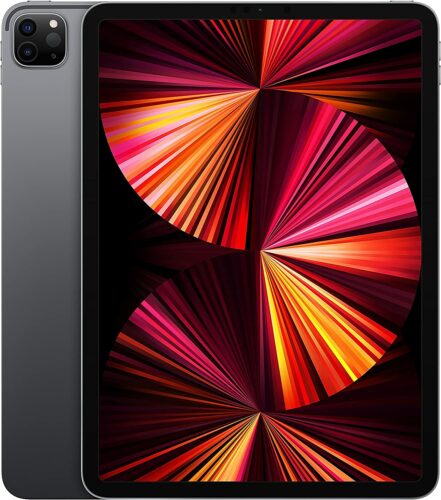
|
Version/Model |
2021 |
2022 |
|
CPU |
Apple M1 chip (8-core CPU) |
Apple M2 chip (8-core CPU) |
|
GPU |
Apple M1 chip (8-core GPU) |
Apple M2 chip (10-core GPU) |
|
Display |
11” (2388×1668) or 12.9” (2732×2048) |
11” (2388×1668) or 12.9” (2732×2048) |
|
Memory |
8GB or 16GB |
8GB or 16GB |
|
Storage |
128GB, 256GB, 512GB, 1TB or 2TB |
128GB, 256GB, 512GB, 1TB or 2TB |
|
Battery |
28.65 Wh or 40.88 Wh |
28.65 Wh or 40.88 Wh |
|
Accessories |
Apple Pencil, Magic Keyboard, Cover (Smart Folio) |
|
|
Price |
From 649.99 |
From $799.00 |
First on our list is the iPad Pro. Considering it is manufactured by Apple, you are probably expecting great things. And the most recent versions of the popular tablet computer, powered by the company’s own ARM-based chip, do not disappoint. They continue Apple’s grasp of the tablet market.
The latest version announced on October 18, 2022, the iPad Pro 2022, sports Apple’s latest M2 chip. According to Apple’s press release, the M2 chip, which features an 8-core CPU, is up to 15% faster than the M1 chip used in its predecessor, iPad Pro 2021, while its 10-core GPU delivers 35% faster graphics performance. Other unique features include 100GB/s of unified memory bandwidth (50% more than M1).
At the time of updating this article, the M2 iPad Pro had not yet been made available in stores. And when it finally lands on the shelf, it will be a tad more expensive. So, if you are looking to purchase a cheaper but powerful iPad Pro, you can go for the one powered by the equally powerful M1 chip, which was announced on April 20, 2021. According to Apple’s press release, the M1 chip, which has an 8-core CPU, delivers up to 50% faster performance than the A12Z bionic chip that powered the 2020 version of the tablet. In addition, Apple claims the 8-core GPU delivers up to 40% faster GPU performance.
For enhanced functionality, this tablet computer has three main accessories: Apple Pencil, a Bluetooth tracking stylus; a magnetic, attachable smart keyboard christened the Magic Keyboard; and a smart cover that Apple calls the Smart Folio. These accessories are sold separately.
These performance and power make the iPad Pro ideal for even the most demanding workflows, including the design of architectural and engineering drawings. In fact, there are a number of CAD applications available for iPad, including ARES Commander, Fusion 360, Tinkercad, Shapr3d, AutoCAD, Onshape CAD, and more.
2. Microsoft Surface Pro
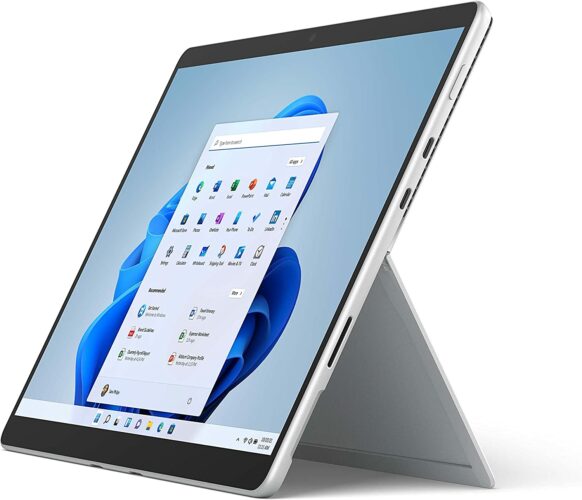
|
Version/Model |
Surface Pro 8 |
Surface Pro 9 |
|
CPU |
Intel Core i5 or Core i7 (built on the Intel Evo platform) |
Intel Core i5 or Core i7 (built on Intel Evo platform) or Microsoft SQ3 processor |
|
GPU |
Intel Iris Xe Graphics |
Intel Iris Xe Graphics or Microsoft SQ3 Adreno 8CX Gen 3 |
|
Display |
13” (2880×1920) |
13” (2880×1920) |
|
Memory |
8, 16, 32 GB |
8, 16, 32 GB |
|
Storage |
512GB or 1TB SSD |
128GV, 256GB, 512GB, 1TB SSD |
|
Battery |
51.5 Wh |
47.7 Wh |
|
Accessories |
Surface Pro X Keyboard, Surface Slip Pen 2 |
Surface Slim Pen 2, Surface Pro Signature Keyboard, Surface Dial |
|
Price |
From $699.99 |
From $799.00 |
On October 12, 2022, Microsoft introduced new Surface devices, revamping its already powerful lineup of products. Among the new updates is the Microsoft Surface Pro 9, which according to preliminary reviews, is faster than the Surface Pro 8. The Surface Pro is a tablet that can still serve as or even replace a laptop. It offers touch capabilities, a full-size precision touchpad, and a productive keyboard. In that regard, it is a 2-in-1 device.
The Surface Pro 9 is powered by either the latest 12th Generation Intel Core processor built on the Intel Evo platform or the Microsoft SQ3 processor. The latter is powered by the Qualcomm Snapdragon platform and is, therefore, an ARM-based processor. According to Microsoft, the Surface Pro 9 is packed with up to 50% more performance than its predecessor, the Surface Pro 8. The internal components are encased in a high-grade aluminum casing and a 13-inch PixelSense display with up to 120Hz refresh rate. Other features include up to 32 GB of RAM and up to 1TB of SSD storage.
The introduction of the new generation of Surface Pro tablets, however, does not render the previous generation obsolete. In fact, you can save some backs by going for the Surface Pro 8, which is powered by the previous generation (11th Gen) Intel chips. According to reviews, however, the previous generation chips take a performance hit because they do not have the performance and efficiency cores found in the latest generation. Still, the processor and, by extension, the Surface Pro 8 tablet is powerful and cheaper.
3. Samsung Galaxy Tab S9 Series
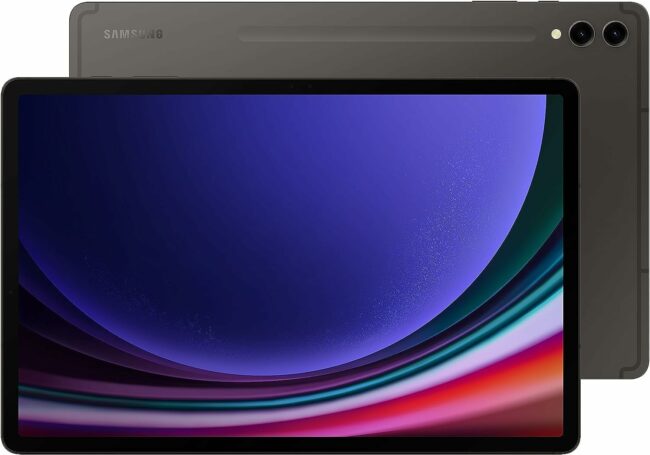
|
Model |
Tab S9 |
Tab S9 Plus |
Tab S9 Ultra |
|
CPU |
Qualcomm Snapdragon 8 Gen 2 |
||
|
GPU |
Adreno 740
|
||
|
Display |
11” (2560 x 1600) |
12.4” (2800 x 1752) |
14.6” (2960 x 1848) |
|
Memory |
8GB or 12GB |
12GB |
12GB or 16GB |
|
Storage |
128GB or 256GB |
256GB or 512GB |
256GB, 512GB or 1TB |
|
Battery |
8,400mAh |
10,090mAh |
11,200mAh |
|
Accessories |
S Pen, Book Cover Keyboard |
||
|
Price |
$469.00 |
From $999.00 |
From $1,100 |
For hardcore fans of the Android OS who require the power of a laptop computer and the larger screen of a tablet, look no further than the Galaxy Tab S9 family. Announced in July 2023 to redefine the tablet landscape and set new standards for creative freedom and immersive viewing, according to Samsung’s news release, the Galaxy Tab S9 series includes three models: Galaxy Tab S9, S9+, and S9 Ultra.
The Galaxy Tab S9 series features, for the first time on a Galaxy tablet, advanced vapor chamber technology, which aids in cooling. As a result, the Galaxy Tab S9 series can be used for intensive tasks that require a great amount of CPU and GPU resources, such as CAD rendering, streaming, gaming, or video editing. Behind the tablets’ raw power is the flagship Qualcomm Snapdragon 8 Gen 2 CPU, which also powers Samsung’s latest flagship smartphones. The octa-core CPU can clock up to 3.36GHz, with the graphics processing handled by the Adreno 740 GPU.
The three models have different battery capacities: 8,400mAh, 10,090mAh, and 11,200mAh. However, they are equipped with automatic capabilities that enable them to switch from 60 to 120Hz and vice versa. This way, the Samsung Tabt S9 series balances battery efficiency and smooth responsiveness of the screen.
Moreover, the models cater to different categories of users, especially those whose preferences are tied to the display size. The base model, the Tab S9, has an 11-inch AMOLED screen. The Tab S9+ has a 12.4-inch AMOLED screen, making it slightly smaller than the 12.9” iPad Pro. Lastly, the Tab S9 Ultra has a 14.6-inch screen, which puts it on par with some laptop screens. This makes the S9 Ultra ideal for use cases that require a large screen but with the convenience, portability, and lightweight attributes of a tablet. Covering these internal components is what Samsung dubs its strongest Armor Aluminum frame ever.
Regarding accessories, the Samsung Galaxy Tab S9 series tablets come with an IP68 water-resistant S Pen. You can also connect the tablets to an external keyboard, the Samsung’s Book Cover Keyboard; however, the keyboard is sold separately.
4. HP Spectre X360 (2-in-1)
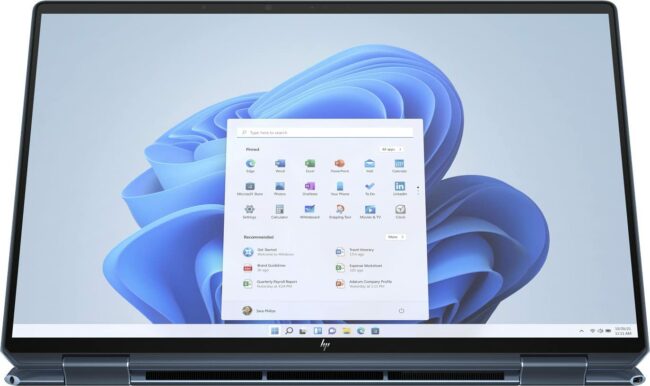
|
Model |
13.5” HP Sprectre X360 |
16” HP Spectre x360 |
|
CPU |
13th generation, 10-core Intel Core i5 or i7 CPUs |
13th generation Intel Core i7 CPUs with 12 cores or 14 cores |
|
GPU |
Intel Iris Xe Graphics integrated GPU |
Intel Arc A370M Graphics dedicated mobile GPU with 4GB video memory |
|
Display |
13.5” (1920 x 1280) or 13.5” (3000 x 2000) OLED display |
16” (3072 x 1920) display or 16-inch (3840 x 2400) OLED display |
|
Memory |
16GB or 32GB |
|
|
Storage |
512GB, 1TB, or 2TB |
|
|
Battery |
66 Wh |
83 Wh |
|
Accessories |
Rechargeable MPP2.0 Tilt Pen |
|
|
Price |
From $999.00 |
From $1,249.00 |
The HP Spectre x360 comes in two sizes: the 13.5-inch model and the 16-inch model. While both models are quite capable, the latter’s larger size might have influenced the inclusion of a dedicated graphics card, which is not present in the smaller version.
13.5-Inch Spectre x360
The 13.5-inch Spectre x360 is powered by 13th-generation Intel Core i5 or Core i7 processors, each with 10 cores and the ability to clock up to 5.0 GHz. The graphics processing for all the various laptop configurations is powered by the Intel Iris Xe Graphics, which utilizes onboard RAM instead of dedicated video memory.
16-Inch Spectre x360
On the other hand, the 16-inch model is powered by the 13th generation Intel Core i7 processors. You can choose a CPU with a 12-core or 14-core architecture. However, most CAD programs are designed to utilize a single core. In this regard, this feature will not affect the performance of CAD-related tasks. The 16-inch Spectre x360 has a dedicated graphics card, the Intel Arc A370M. This dedicated mobile GPU is paired with dedicated 4GB video memory. Accordingly, compared to the smaller version, the 16-inch model is better suited to handle tasks that are otherwise heavy on the graphics card, including simulation and rendering.
The bigger model also has a superior display and a bigger battery. The other features – the memory and storage capacities – are nonetheless the same for both models. In fact, the 13.5-inch and 16-inch Spectre x360 both have an SD card reader slot, 2 Thunderbolt 4 with USB-C ports with DisplayPort over USB-C capability and support a transfer rate of 40 Gbps, a SuperSpeed 10Gbps USB-A port, headphone jack, and a HDMI port. Additionally, both are made of recycled metal, which is used in the cover, keyboard frame base, hinge caps, and drop jaw.
5. ASUS Vivobook S Flip (2-in-1)
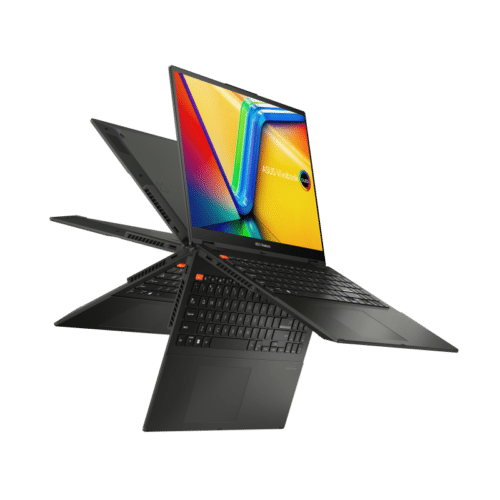
|
Model |
ASUS Vivobook S 14 Flip |
ASUS Vivobook S 16 Flip |
|
CPU |
AMD Ryzen 7 7730U |
AMD Ryzen 7 7000 series or 13th generation Intel Core i5, i7, or i9 |
|
GPU |
AMD Radeon integrated graphics |
Intel HD Graphics or Intel Iris Xe Graphics |
|
Display |
14-inch (1920 x 1200) |
16-inch (1920 x 1200) |
|
Memory |
Up to 16GB |
Up to 16GB |
|
Storage |
Up to 1TB |
Up to 1 TB |
|
Battery |
50 Wh |
50 Wh (AMD-powered) or 70 Wh (Intel-powered) |
|
Accessories |
ASUS Pen 2.0 |
|
|
Price |
From $899.99 |
From $599.99 |
The ASUS Vivobook S Flip comes in two sizes: the 14-inch S 14 Flip and the 16-inch S 16 Flip. Both are 2-in-1 convertible laptops that feature a 360° hinge that affords you, the user, the freedom to determine the extent to which you can open the laptop. Thanks to this freedom, they can be used in tent, stand, or tablet mode, or anything in between, yet still retain the power and capabilities of a laptop computer.
Vivobook S 14 Flip
The smaller Vivobook S 14 Flip is supercharged by AMD’s Ryzen 7 7000 series mobile CPUs, specifically the Ryzen 7 7730U, with integrated AMD Radeon Graphics. The CPU has up to 8 cores, which aids in multitasking (if need be). Cooling is provided via upgraded heat pipes that are paired with an IceBlade fan that efficiently accelerates heat transfer. It comes equipped with up to 16GB memory and up to 1TB SSD storage. This device also sports a 2K full HD touchscreen display with a resolution of 1920 x 1200 pixels.
The Vivobook S 14 Flip features a reinvented touchpad that facilitates number input with the tap of the touchpad icon. This creates an underlay of numbers and mathematical symbols in what ASUS calls the NumberPad 2.0.
Vivobook S 16 Flip
On the other hand, the larger Vivobook S 16 Flip can be powered by AMD’s Ryzen 7 7000 series mobile CPUs or Intel’s 13th generation Core i5, Core i7, or Core i9 processors. Its graphics processing is handled by the integrated Intel HD Graphics. However, it can be configured with the integrated Intel Iris Xe Graphics, provided it has dual-channel memory.
Both the Vivobook S 14 Flip and Vivobook S 16 Flip have 1 USB 3.2 Gen 2 Type-C that supports up to 10Gbps data transfers, 1 HDMI 2.1 port, 2 USB Type-A ports, and an audio jack. You can also use the optional ASUS Pen 2.0, sold separately, to draw, sketch, or doodle without worrying about scratching the screen.
6. Samsung Galaxy Tab A Series
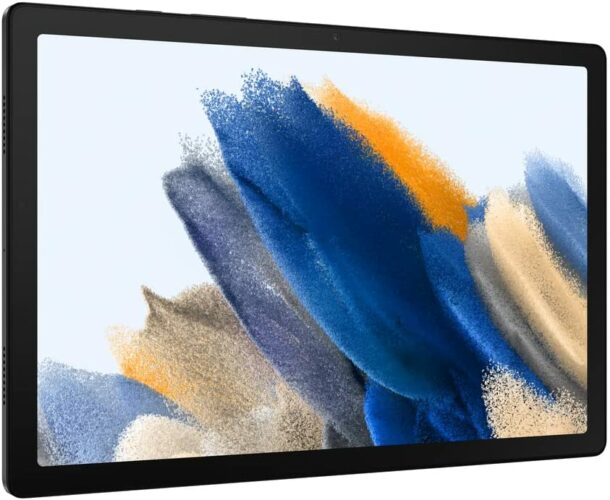
|
Model |
Samsung Galaxy Tab A8 |
Samsung Galaxy Tab A9 |
Samsung Galaxy Tab A9+ |
|
CPU |
Unisoc Tiger T618 |
Mediatek Helio G99 octa-core CPU |
Qualcomm Snapdragon 695 octa-core |
|
GPU |
Mali G52 MP2 |
Mali-G57 |
Adreno 619 |
|
Display |
10.5” (1920×1200) |
8.7” (1340 x 800) |
11.0” (1920 x 1200) |
|
Memory |
2GB (or up to 4GB) |
4GB (or up to 8GB) |
4GB (or up to 8GB) |
|
Storage |
32GB (or up to 128GB) |
64GB or 128GB |
64GB or 128GB |
|
Battery |
7,040mAh |
5,100mAh |
7,040mAh |
|
Accessories |
None |
Book Cover and Book Cover Keyboard Slim |
|
|
Price |
From $149.99 |
From $205.00* |
From $229.00* |
| * Prices converted to USD from Hong Kong Dollars (HKD) | |||
Given the numerous CAD software specifically developed to run seamlessly on Android, the Samsung Galaxy Tab A series makes for the best budget tablet. In October 2023, Samsung launched the new lightweight budget tablets, the Samsung Galaxy Tab A9 and Tab A9+, starting with select markets. The new tablets are meant to replace the Samsung Galaxy Tab A8, released in 2021. The inclusion of the Tab A8 in the table above stems from the fact that the Tab A9 and Tab A9+ have yet to be made available globally.
Galaxy Tab A8
The Galaxy Tab A8 is powered by the ARM-based Unisoc Tiger T618 octa-core CPU capable of clocking about 2GHz. A dedicated GPU, the Mali G52 MP2, handles the graphics processing. The Galaxy Tab A8’s memory ranges from 2GB to 4GB, with internal storage ranging from 32GB to a maximum of 128GB, depending on the configuration you choose. It has a 7,040mAh battery and a 10.5-inch screen that offers brilliant clarity thanks to its HD resolution. The Galaxy Tab A8 runs Android 11, which can be upgraded to the latest version, Android 13.
Galaxy Tab A9+
But if you want to buy the latest in Samsung’s budget tablet lineup, consider the Tab A9 or Tab A9+, which are formidable replacements for the Tab A8. The Samsung Galaxy Tab A9 is powered by the Mediatek Helio G99, which has eight cores; two of these cores can clock 2.2GHz, with six of them clocking 2.0GHz. It relies on the Mali-G57 MC2 GPU to process the graphics displayed on the 8.7-inch screen with a 1340 x 800 resolution. But compared to the A8, the A9 has a smaller battery, which will likely impact the battery life.
Thus, if you want a budget tablet with a bigger battery, the Samsung Tab A9+ fits the description. It has a 7,040mAh battery, similar to its predecessor, the Tab A8. But it has improved features, including the Qualcomm Snapdragon 695 octa-core CPU that can clock 2.2GHz, the Adreno 619 GPU, and a bigger 11-inch screen. Compared to the Tab A9, the Tab A9+ has a better screen resolution – 1920 x 1200 – meaning it boasts better clarity. That said, the A9 and A9+ share the same memory and storage capacities, much higher than the Tab A8. In addition to the built-in storage, the lightweight tablets have a microSD card slot that lets you add up to 1TB of storage.
In terms of connectivity, the Tab A8, A9, and A9+ each have a 3.55mm headphone jack and a USB-C 2.0 port. The latter supports fast charging. However, the port does not support DisplayPort over USB-C or MHL. This, therefore, means that you cannot connect these tablets to an external monitor.
Tablets vs 2-in-1 Laptops for CAD
Tablets and 2-in-1 laptops are both capable devices, each with its advantages and its fair share of disadvantages. Therefore, when choosing between tablets and 2-in-1 laptops, there are plenty of considerations you should make, from pricing and portability to performance, connectivity, and functionality.
Tablets
While tablets lack a permanently attached keyboard or trackpad and have fewer ports, they are not necessarily cheap. Professional-grade tablets can be as costly as, or even surpass the price of, some business laptops. Of course, there are budget tablets; however, they cannot handle demanding CAD-related tasks as excellently as pro tablets can.
Pros of Tablets
- Tablets are easy to handle thanks to their thin form factor and compactness
- They are extremely portable because they are lighter
- Tablets can offer the laptop form factor by adding a keyboard with a built-in trackpad
- The latest tablet offerings from Apple and Samsung are equipped with the fastest processors, which make them powerful enough to handle demanding CAD tasks
Cons of Tablets
- Tablets have more limited functionality compared to 2-in-1 laptops
- They are expensive despite being smaller and lacking traditional input tools
- Despite supporting a keyboard, trackpad, and mouse, these peripheral devices are not as seamless to use on the tablets as on the 2-in-1 laptops
- They cannot run desktop applications; on their part, iPads cannot access or run macOS software
2-in-1 Laptops
2-in-1 devices are laptops whose hinge(s) support(s) a 360° rotation. They have permanently attached keyboards and touchpads. Such laptops can be used in laptop, tent, stand, or tablet mode. In tablet mode, the base panel containing the keyboard, motherboard, and battery rotates around the hinge such that the panel’s cover rests behind the top panel, which covers the back of the screen.
The 2-in-1 laptops are much thicker than tablets, a factor that, though makes them bulkier and heavier, provides enough room to pack in beefier internal components. For this reason, these laptops beat most, if not all, tablets in terms of performance. This means that 2-in-1 laptops are essentially a case of the performance vs. handling trade-off.
Pros of 2-in-1 Laptops
- They provide access to full-featured desktop applications
- 2-in-1 laptops have a wider selection of ports
- These laptops have more real estate for expansion, including additional RAM slots or SSD
- They are generally bigger, meaning they can be equipped with more powerful CPUs and dedicated GPUs
- Their displays can support higher resolutions than tablets, including 4K
Cons of 2-in-1 Laptops
- 2-in-1 laptops are bulkier and thicker than tablets, especially when in tablet mode, making them less comfortable
- In tablet mode, the keyboard and touchpad of 2-in-1 laptops are hidden, affecting the user experience.
Frequently Asked Questions
- What’s the minimum RAM and storage requirement to run CAD software smoothly on a tablet?
For most CAD software to work smoothly on a tablet, you require, at the very minimum, 8GB RAM and 128GB storage. However, the recommended specs are much higher. Larger memory and storage capacity boost performance, enabling the device to handle the demanding requirements of CAD applications. - Are tablets as effective as desktop devices for CAD tasks?
No. There are several reasons why tablets are not as effective as desktop devices for CAD tasks. These reasons can broadly be grouped into hardware-related bottlenecks and tablets’ unfavorable user experience. First, tablets have fixed, unupgradable hardware. As expected, fixed hardware can limit performance due to potential bottlenecks.
Another factor that hinders the effectiveness of tablets compared with desktop devices is the lack of keyboard shortcuts. Multiple applications support shortcuts, which aim to ease and quicken the workflow. Examples include SolidWorks keyboard shortcuts, FreeCAD keyboard shortcuts, BricsCAD keyboard shortcuts, LibreCAD keyboard shortcuts, and SketchUp keyboard shortcuts, just to mention a few.
That said, some developers have optimized their CAD applications for tablets. As a result, such applications support multi-touch gestures, the stylus pen, keyboard, mouse, and more. Still, the workflow on desktop computers is smoother because most CAD applications were originally designed for desktop use. - Is there a difference in performance between Windows, iPadOS, and Android for CAD applications?
Yes. Most powerful CAD software applications are biased towards the Windows OS, i.e., they are created to run only on Windows devices. In essence, many CAD applications are specifically optimized for Windows. Given that Windows tablets, often 2-in-1 laptops, support styluses, touch functions, mice, and multiple monitors, along with having a permanently attached keyboard, they are better than iPadOS or Android tablets for CAD applications. With Windows tablets, you can enjoy seamless workflow and user experience because of the bigger screens, better multitasking capabilities, the ability to use keyboard shortcuts, and more. - Are there CAD-specific apps optimized for tablet use?
Yes. There are several CAD apps for iPad, that is, apps that can only run on iPadOS; these include SketchUp, uMake, Shapr3d, and Morpholio Trace. Similarly, there are a few CAD apps for Android tablets, namely SketchUp Viewer. Others like Tinkercad, Fusion 360, uMake, Onshape, CorelCAD Mobile, and Roomsketcher are supported by both iPads and Android tablets. This is because they are available as native applications on both iPadOS and Android. Moreover, tablets can easily run web-based CAD software like Onshape and AutoCAD Web.
Additionally, some desktop CAD applications, such as Bluebeam Revu, SolidWorks, and Siemens NX, are optimized for Windows tablets running the latest version of the OS. This is because they support the Surface Dial and the stylus pens, delivering an immersive CAD experience. The Surface Dial optimizes CAD workflow by bringing the most-used tools and shortcuts directly onto the screen with simple turns and presses of the Dial. Generally, the various software applications let you use the Surface Dial to pan, zoom, rotate, and manipulate view attributes of 3D models. All you have to do is place the Dial directly on the screen and rotate or press the dial. - How essential is a stylus or pen for CAD work on a tablet?
While styluses are not necessary, they have numerous advantages, especially in CAD-related applications. This somewhat speaks to how essential they are, but it sometimes boils down to personal preferences and what you intend to use the tablet for. Styluses or pens offer flexibility by adding a new way of interacting with the CAD software as well as designs and models therein beyond the traditional inputs and the touch screen. They improve comfort by reducing wrist strain. They also reduce unnecessary fingerprint smudges and enhance the accuracy of touch actions and the precision of sketches. By using a stylus, you do not have to worry about using the undo button because of cases of fat fingers, such as pressing the wrong button. - What screen resolution and size are optimal for CAD work?
A minimum resolution of 1080p, also known as full HD, is optimal for CAD work on a tablet. Generally, a high screen resolution is desirable because it gives you a greater sense of precision when looking at or working on objects with complex geometry. Additionally, a high resolution enables you to better understand the aesthetics of your design during the creation process.
Although a higher resolution like 4K is appealing, it may not be practical for tablets due to limited screen size and the shorter viewing distance compared to, say, a TV screen or computer monitor. As a result of these factors, 4K tablets would lose the details that 4K screens are supposed to afford you. This is why most tablets – including 100% of those in our list – do not have 4K screens. The clear exception is some 2-in-1 devices. - Is it possible to connect my tablet to an external monitor for a larger workspace?
Yes, it is possible, albeit with a few caveats. Modern tablets have a USB-C port, which can transmit data at 20GBps, or a Thunderbolt port, which has a bandwidth of 40GBps. The ability to transmit data at high speed enables them to send video signals, meaning you can use the ports to connect your tablet to an external monitor. But there are a few factors you should take into account.
For USB-C ports to send audio and video signals to a monitor, they must support DisplayPort over USB-C or MHL. This means that not all tablets can be connected to an external monitor. However, if your tablet has a Thunderbolt-3 port, it can connect – and send video signals – to one 4K monitor. If it has a Thunderbolt-4 port, it can send video signals to two 4K displays or one 8K monitor. It is necessary to keep in mind that you must use Thunderbolt cables with the Thunderbolt ports to enjoy this capability. - Is investing in the latest tablet model worth it or will older models suffice for CAD work?
You do not need to purchase the latest tablet model, as the older model will still get the CAD work done. This is primarily because CAD applications for tablets are meant to run universally on most of the latest tablets. Trimble recommends using the most powerful M1 iPad. In fact, the iPad system requirements for Shapr3D, for instance, show that the application can run on all generations of the iPad Pro, the 4th and later generations of the iPad Air and iPad mini, and the 6th and later generations of the iPad. Similarly, Sketchup for iPad works with various iPad models, including iPad, iPad Pro, iPad Air, and iPad Mini.
However, if your work involves working with large, demanding CAD models that your current tablet cannot handle, you could consider investing in the latest tablet model, such as the M1 or M2 iPad.
Conclusion
Tablets are known to offer a few advantages over conventional laptops. For example, they are thin and lightweight, and boast a longer battery life because they have less hardware. At the same time, however, 2-in-1 laptops exist. These convertibles combine some of the benefits of tablets with the advantages of laptops. These facts informed our list of the best tablets for CAD as it contains both tablets, such as the iPad Pro, Samsung Galaxy Tab S8, and Microsoft Surface Pro 8 and 9, as well as 2-in-1 laptops, namely HP Spectre x360 and ASUS Vivobook S 14 Flip. These tablets further stand out in different categories as follows:
- Best Windows tablet: Microsoft Surface Pro 9
- Best Android tablet: Samsung Galaxy Tab S9
- Best Apple tablet: iPad Pro (2022)
- Best tablet below $500: Samsung Galaxy Tab A9
- Best tablet above $1,000: Microsoft Surface Pro 9 (fully specced out)
- Best 2-in-1 laptop: 16-inch HP Spectre X360
- Best overall tablet: Microsoft Surface Pro 9
